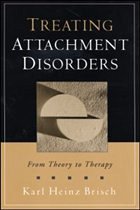Table of contents:
Part 1: Attachment Theory and Its Basic Concepts. Historical Overview. The Development of the Concepts of Attachment Theory. Part 2: Attachment Disorders. Attachment and Psychopathology. The Theory of Attachment Disorder. Attachment Classification in Diagnostic Manuals. The Diagnosis and Typology of Attachment Disorders. Part 3: Attachment Therapy. Therapeutic Theory. Treatment Technique. Part 4: Treatment Cases from Clinical Practice. Manifestations of Attachment Disorders Prior to Conception. Prenatal Attachment Disorders. Postnatal Attachment Disorder. Attachment Disorders in Childhood. Attachment Disorders in School-Age Children. Attachment Disorders in Adolescence. Attachment Disorders in Adults. Summary. Part 5: Prospects for Further Application. Family Therapy. Group Psychology. Education. Critical Issues. Afterword. Appendix: Brief Precis of the Adult Attachment Interview Protocol.
Attachment theory and research have greatly enhanced our understanding of the role of parent-child relationships in the development of psychopathology. Yet until now, little has been written on how an attachment perspective can be used to actively inform psychotherapeutic practice. In this invaluable work, Karl Heinz Brisch presents an attachment-oriented framework for assessing and treating patients of all ages. Illuminated are the ways that early experiences of separation and loss can lead to a range of psychological, behavioural, and psychosomatic problems, and how these can be addressed in the context of a healing therapeutic relationship. Bridging a longstanding divide between the seminal work of John Bowlby and the concepts and methods of psychodynamic therapy, the book is richly illustrated with evocative clinical material.
In this invaluable work, Karl Heinz Brisch presents an attachment-oriented framework for assessing and treating patients of all ages.
Part 1: Attachment Theory and Its Basic Concepts. Historical Overview. The Development of the Concepts of Attachment Theory. Part 2: Attachment Disorders. Attachment and Psychopathology. The Theory of Attachment Disorder. Attachment Classification in Diagnostic Manuals. The Diagnosis and Typology of Attachment Disorders. Part 3: Attachment Therapy. Therapeutic Theory. Treatment Technique. Part 4: Treatment Cases from Clinical Practice. Manifestations of Attachment Disorders Prior to Conception. Prenatal Attachment Disorders. Postnatal Attachment Disorder. Attachment Disorders in Childhood. Attachment Disorders in School-Age Children. Attachment Disorders in Adolescence. Attachment Disorders in Adults. Summary. Part 5: Prospects for Further Application. Family Therapy. Group Psychology. Education. Critical Issues. Afterword. Appendix: Brief Precis of the Adult Attachment Interview Protocol.
Attachment theory and research have greatly enhanced our understanding of the role of parent-child relationships in the development of psychopathology. Yet until now, little has been written on how an attachment perspective can be used to actively inform psychotherapeutic practice. In this invaluable work, Karl Heinz Brisch presents an attachment-oriented framework for assessing and treating patients of all ages. Illuminated are the ways that early experiences of separation and loss can lead to a range of psychological, behavioural, and psychosomatic problems, and how these can be addressed in the context of a healing therapeutic relationship. Bridging a longstanding divide between the seminal work of John Bowlby and the concepts and methods of psychodynamic therapy, the book is richly illustrated with evocative clinical material.
In this invaluable work, Karl Heinz Brisch presents an attachment-oriented framework for assessing and treating patients of all ages.
